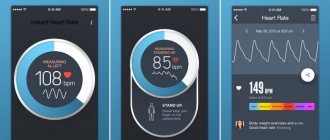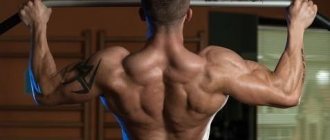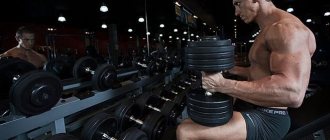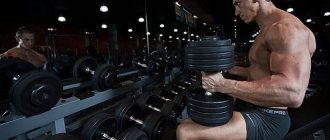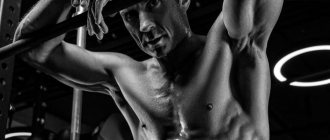We learned from a fitness trainer how to start pumping up your body if you are still new to this, and how not to harm yourself.
– To begin with, I would like to note two important points. Firstly, the decision about any transformation of your body must be conscious. When a person, looking at himself in the mirror, thinks: “Yes, it’s really time,” in this case he has a much greater chance of achieving the desired result.
Victor Shpakovsky
personal fitness trainer, nutritionist
But, unfortunately, what often happens is completely different: beautiful bodies are followed by guys and girls who were told by someone that they have gained weight and so on. And such motivation, to be honest, is not very good for starting. Many, trying to keep up with other people's desires, lose themselves. Practicing any sport (badminton, boxing or gym) should be fun.
Secondly, you need to be patient. Imagine: we spent years bringing our body to the state it is in now, and then suddenly we decide to quickly get ourselves in order.
But it is impossible to correct the situation in 2-3 months (or even in six months) - this requires much more time. Those magical transformations, as they show us on Instagram with “before/after” photos over a couple of months, are either just a collage or have nothing to do with health. Most people who go through such “miracle” transformations gain even more weight in a very short time than they originally had.
Before you start improving your body, should you visit a doctor?
– To play sports, say, in a gym or fitness room, no health certificates are required. If you do not have chronic diseases of the cardiovascular system, musculoskeletal system, or endocrine glands that you would probably know about, you can go and practice.
If you have certain health-related restrictions, then it is better to first go to an appointment with a specialist for an examination. After all, not every coach is a doctor, and it’s not good to shift responsibility from yourself to him. The doctor will tell you which exercises are available to you and which ones are best avoided (for example, high-intensity cardio exercises).
But in general, any good trainer at the first lesson is obliged to ask his client whether he has any health limitations or whether there have been serious injuries, so that if something happens, he can select the load for this particular person. If the coach forgot to clarify this point, do not hesitate to tell him about it yourself.
But what is more effective: a gym, group fitness or home workouts?
– Here it all depends solely on what you like best. The main thing is not to force yourself or force yourself. But if we are talking specifically about the effectiveness of classes (involvement of muscle groups and impact on them), then working in the gym will be preferable to other areas of fitness.
I won’t say anything against yoga, Pilates, running and other things, but strength training will best provide long-term effects on muscles .
For beginners, I can advise you to install the Muscle & Motion application: there you can find a variety of exercises and find out which muscles are involved and how they are used.
Example: we are running on a track or doing aerobics, we are done - this is where the impact on the muscles ends. But a full-fledged strength training with dumbbells has ended - and the processes of anabolism (transformation, synthesis) in your body will continue for a very long time. Recovery after strength training takes up to a week, and during this time the body will spend calories on this recovery.
How the body changes after training. Types of exercises and their consequences
The gym is an excellent option for building muscles, not for losing weight
ABS and strength training - strengthen the body, increase the density and elasticity of the skin, increase strength by strengthening the muscles, improving the figure and posture by strengthening the muscles.
Aerobic exercises - less centimeters in the contours (reduction of body fat), increased physical fitness and condition, “lightness” of posture, general strengthening of the body.
Yoga , Pilates is a group of exercises that, in addition to physical benefits, primarily provides inner peace, stress, relaxation, strengthening, stretching and elasticity of muscles, slim figure, oxygenation (the pace is slow, so you can work on learning how to breathe correctly) .
Exercises with the ball - in addition to strengthening and stretching muscles, reducing back pain, significantly improving coordination and balance, and relieving stress.
Aerobics and choreographic exercises - these teach physical memory, self-control and proper movement, some classes include dance steps.
Dance or exercises with elements of dance , such as Zumba , are a group of exercises ideal for people who do not like the monotonous repetition of traditional workouts, exercises with an element of dance increase confidence, improve well-being, change the perception of themselves and their body, as well as everything around them !
Thanks to movement (regardless of the type of activity) you will get a lot:
- self confidence;
- better health;
- greater awareness of your body;
- You relieve stress!
- better immunity and a feeling of gratitude for doing something for yourself and your body;
- coordination and mobility, which is also useful in everyday life.
ALSO read: Why is it difficult to lose weight without fitness: advice from a trainer
Is it better to start working out with a trainer or can you do it on your own?
– Our body doesn’t care where we get stress on our muscles: on the street with dumbbells, at home with elastic bands, or in the gym. The main thing is that there are conditions for progress (increasing the volume and intensity of the load).
At home, for example, it is difficult to work a muscle from different angles. But I know a lot of people who started with this and then went to the gym. Well, it often happens that motivation disappears faster when training at home than under the supervision of a trainer, who can both scold and praise.
Plus, the choice of equipment in the gym is much wider: dumbbells, barbells, exercise machines, which make the task very easy. For beginners, whose ligaments, tendons and joints are still weak, it is quite difficult to practice at first. Therefore, in my opinion, it is better to start with a trainer: it will be more effective, more educational and safer.
If you don’t have the opportunity to work with a trainer, say, for a whole year, take a month. During this time, they will have time to explain the main points to you, show you which exercises are right for you, and then practice on your own.
Or beginners who don’t want to work with a trainer can take training courses themselves. You will know what exercises to do, how, why and in what order. And also understand the training process itself.
The fight against complexes: a turning point and the beginning of transformation
At the age of 18, Tanya met her future husband Dima. He encouraged the girl to get a higher education and quit a job that was harmful to her health. According to the blogger, after leaving the cafe she was plump without a single hint of sports.
Photo: instagram.com/tanyatgym/
One day the couple went to visit Dima’s parents at their dacha. The guy took a photo of the girl in a swimsuit while she was sitting on the side of the pool. The photo turned out to be significant for Tanya. And the young man carefully hinted to his beloved about some flaws in her figure.
The first thing that came to Tanya’s mind was to try a diet based on apples and kefir, which the girl soon became disillusioned with. She began training at home with dumbbells: doing squats and bendings. At the same time, the blogger became even more complex. She was afraid of herself and tried not to look people in the eyes. To get rid of a serious problem, Tanya went to a modern dance studio. At first the girl felt uncomfortable, but then she made friends with her peers and relaxed.
Photo: instagram.com/tanyatgym/
Only after this did the blogger take the issue of training seriously. She began to study the correct exercise technique, adjust her diet with her future husband, and understand the meaning of proteins, fats and carbohydrates. Tanya realized that she could achieve excellent results at home and created a YouTube channel to share her experience with other people.
View this post on Instagram
Over time, Tanya felt that homework was not enough for her. Therefore, she and her husband decided to go to the gym. There the girl learned that you can not only lose weight, but also build muscle mass by resorting to dietary supplements.
7 home workouts. How not to gain weight during quarantine
Experiment: How I ate healthy on just $2 a day?
How many times a week should I train if I'm a beginner?
– For starters, 2-3 times a week will be enough. Ideally, of course, three times: this way you will have enough time to load your muscles, but there will also be enough rest. If after a couple of months you realize that this amount is no longer enough for you, you can try adding another workout. But from my experience, training 4-5 times a week is rare.
It often happens that beginners start with one workout per week, gradually increasing the number. Yes, this is better than nothing, but it is difficult to expect any result in this case, especially if the person came not just to maintain a figure, but also wants to study the topic and achieve a certain result.
But it also happens the other way around: a person starts with three times a week, but in the end he cannot bear the load - the body needs to recover. Unfortunately, many people think that the more time they spend in the gym, the more times they lift the dumbbell, the better. In fact, we “grow” not during training, but during rest.
How long should one workout take?
– Average training time – 1 hour (maximum 1.5) . This time is enough to do quality work on your body. But it often happens that some try to do it in 20 minutes, while others try to do it in three hours.
By increasing your time, you are not doing yourself any good. Fatigue accumulates, intensity and concentration decrease, the central nervous system becomes tired - this does not allow you to exercise effectively. You definitely won’t grow anything faster this way, but the risk of injury and overtraining will increase.
For example, you worked out in the gym for three hours on Monday: everything hurts, you can barely walk. A day later, when the body has not yet recovered, there is still pain, you come back to study for three hours. On Friday the same thing. Firstly, your indicators stop growing, and secondly, your nervous system will sooner or later say: “I’m tired of it.” And the motivation to train will disappear.
If this condition is not stopped, the risk of injury is very high. And recovery after it can take from one month to six months - this is a very long process. If you worked your legs on Monday, work on your arms and back on Wednesday.
What about your diet? How to compose it?
– Here it is important to understand what we mean by “getting your figure in order.” If a person just wants to be thin, he just needs to adjust his diet and add cardio exercise (for example, running). You will lose weight, the percentage of subcutaneous fat layer will decrease. But if we are talking about acquiring sports shape (building muscle mass, increasing strength, etc.), then nutrition alone (like cardio alone) will no longer be enough.
In theory, you can independently create the right diet for yourself, but practice shows that doing this is quite problematic. Of course, if you understand the principles of healthy eating - that the diet should be varied, balanced and should meet your goals (I mean the energy component or calories) - then why not. But for this you need to really bother and spend a lot of time.
I will say that not even all trainers are involved in preparing a diet: not because they don’t know how, but because it is really a very time-consuming process. Therefore, I would recommend contacting a nutritionist or other specialist who can choose a diet for you.
Here are films about nutrition that are worth watching:
- “I want to change” (Hungry for Change), 2012. A film about the secrets of diets and shocking stories of weight loss.
- "Sugar", 2014. An experimental film in which the hero begins to eat exclusively food labeled "healthy" ("good for health") in order to reveal to the audience the bitter truth about sugar, which is actually hidden in freshly squeezed juices, low-fat yoghurts, muesli and other “healthy” foods.
- Forks Over Knives (2011) An American documentary film that promotes lean, whole food, plant-based eating as a way to avoid or reverse some chronic diseases.
What mistakes do newbies most often make?
– Actually there are a lot of them. If we take three main ones, then these are:
- No warm-up. Many people came to training, waved their hand a couple of times, and started practicing. This can end very badly: the risk of injury doubles or even triples. Warming up triggers internal resources, metabolic processes, warms up joints, ligaments and tendons, that is, it allows the body to wake up and get back to work. And what’s most interesting: the closer you are to a beginner, the more time you need to devote to warming up and the more intense it should be.
- Chasing big weights. The more weight, the greater changes your technique will undergo - and this is not very good. In fact, technique is what gives the real result. Until you perform the exercise perfectly, thinking about taking a dumbbell not 2 kg, but 10, is very stupid.
- Many people believe that you should not drink water during training , as it is supposedly harmful to the heart. But this is not true at all. You can drink before, during and after training as needed. If your coach prohibits you from doing this, you need to think carefully about whether he is really a good specialist.
And here are some more common mistakes:
- Lack of warm-up approaches before workers. To avoid injury, always do one or two warm-up sets before your work sets.
- Lack of insurance when working with heavy weights. Don’t hesitate to ask for backup on the way if you are not confident in your abilities. This is absolutely normal.
- Rest intervals are too long. 1-2 minutes will be enough for you to regain your strength.
- Recovery. As I said before, you grow while you sleep, not while you train. Therefore, it is very important to get 7-9 hours of sleep and recover from strenuous exercise.
How did the first six kilograms go and what changed?
After a month of a responsible attitude to training and diet, the result was not long in coming. Sasha saw a new figure of 106.8 kg on the scales and successfully passed the endurance test, which was difficult for him at the beginning of his journey. It included burpees, light squats and abdominal exercises. All this had to be done in ten repetitions and squeeze out the maximum number of circles in five minutes. Selivanov managed to make 170 movements - 44 more than in the starting test.
Out of 28 years, I only spent one month eating healthy and exercising every day. And here is the result! And if I started two years ago, what would I be like now?
In addition to endurance, Sasha has improved his strength. He did four pull-ups, although initially he could only do two reps, and also did 43 push-ups. The novice athlete himself admitted that he had never withstood more than 20 successful attempts before.
The result of Sasha Selivanov’s weight loss after 30 workouts without equipment:
Photo: youtube.com/user/PrygunovTeam
Photo: youtube.com/user/PrygunovTeam
Photo: youtube.com/user/PrygunovTeam
How quickly will my body begin to change?
– This is a very common question asked to a coach. But here you need to take into account too many factors that influence the result: the training itself, recovery, nutrition, and stress factors.
But in general, if a person follows a diet, a training regimen, then, in principle, after three months you can already feel some changes in yourself, people around you will notice it in six months (but we are not talking about losing weight now: it can be done much faster). Yes, this can happen earlier: I repeat, everyone’s body reacts differently.
Stay away from weights! How the body changes after training
CrossFit
To get off to a good start, maintain your weight! This is difficult because the weight indicator is our most authoritative guide to changes occurring in our body. Unfortunately, this is not a direct reflection of how the body changes after training. When we start training, the body becomes slim and firm, and its size also noticeably decreases. It happens that to achieve the effect of a Brazilian butt you need to gain a few extra pounds!
ALSO READ: Pump up your buttocks at home with a set of 5 exercises
Monitor your body systematically and see the effects here. However, if you want measurable effects for your own motivation, try measuring the circumference with a tape measure rather than weighing it. Remember that the same unit of weight for fat and muscle occupies a different surface area - fat is definitely larger than muscle. Therefore, you must take into account the fact that, despite the visual changes in your figure, the weight may remain the same and even increase.
7 tips on how to recover after a workout helpful.
If I have already done fitness (in the gym), will my body get in shape faster?
– There is such a thing as muscle memory. Imagine that there are some kind of stations, or nuclei, in our muscles - in different quantities for each person. Due to physical activity, stress and other factors, the number of these nuclei increases, and the muscle grows in volume.
At some point, you stopped training and during this time your muscle tone disappeared and their volume decreased. But at the same time, the number of cores in them has not decreased. Therefore, when you return to the gym and start training, the muscle begins to progress faster than for a beginner.
Plus, it’s important to note that your body remembers the technique too. You have already done this exercise once, so remembering how to do it correctly will also not be difficult in a year or two.
Changes in attitude towards sports and life
Before participating in the program, the blogger consistently woke up around noon and sincerely loved fast food, soda, fatty, refined foods. Because of this, Selivanov spent a considerable 30-40 thousand rubles a month on food. In the process of losing weight, he learned to get up at 9 am without an alarm clock, and spend half as much money on healthy products. By the way, although the diet was cut, it remained varied: Sasha allowed himself steaks and avocados. But the main changes occurred in his attitude towards sports and life in general. Selivanov began to study for pleasure. He dealt with difficulties, knowing that it was definitely worth it. And he completely lost interest in fast food.
You can live a fun and cool life without poisoning yourself with junk food.
The coach answers: how to improve endurance?
How to quickly lose 14 kg and not ruin your health?
What should I read to understand the topic?
Since today we are surrounded by a very large amount of information, you should treat everything you read with a grain of salt: do not blindly trust everyone. I would advise beginners to read:
- “Think! Bodybuilding without steroids! (Stuart McRobert) The book is written in simple, accessible language and is aimed at beginners. The author described the basic exercises in detail, placing emphasis on training without the use of pharmacology. However, many criticized the book, since the author himself could not boast of a bodybuilding physique.
- “Anatomy of Strength Exercises for Men and Women” (Frederic Delavier, 5th edition, 2016) Perhaps the best guide for both beginner athletes and experienced fitness trainers. This book is a unique illustrated database of exercises describing the technique from an anatomical point of view.
- "Human anatomy. Body. How it works" (Peter Abrahams, 2016) This book, based on the most modern medical knowledge, outlines the basics of the structure and functioning of the human body. In principle, it will be useful to read any book on human anatomy.
- “Rational nutrition of athletes” (P.I. Pshendin, 2005) The correct approach to nutrition makes 50% of success in bodybuilding, so you need to know and understand what and in what quantities should be eaten to dry muscles, gain muscle mass or lose weight.
- “The Body Building System” (Joe Weider) Considered a classic of “Kachkovsky” literature. Contains many recommendations, explains the principles used in training, and, of course, descriptions of exercises.
Reproduction of CityDog.by materials is possible only with the written permission of the editors. Details here.
Photo: from personal archive, www.pexels.com

